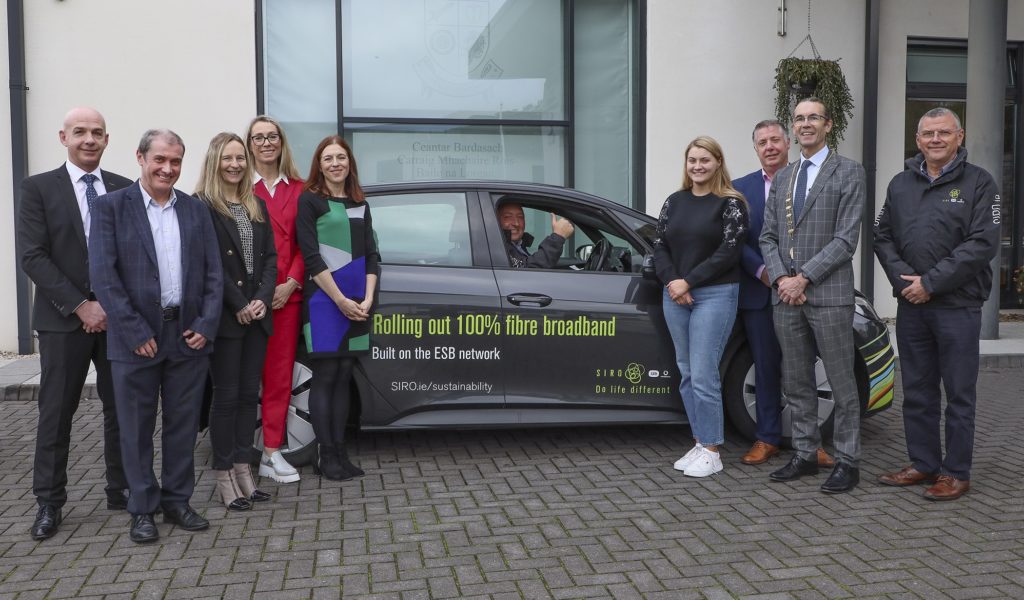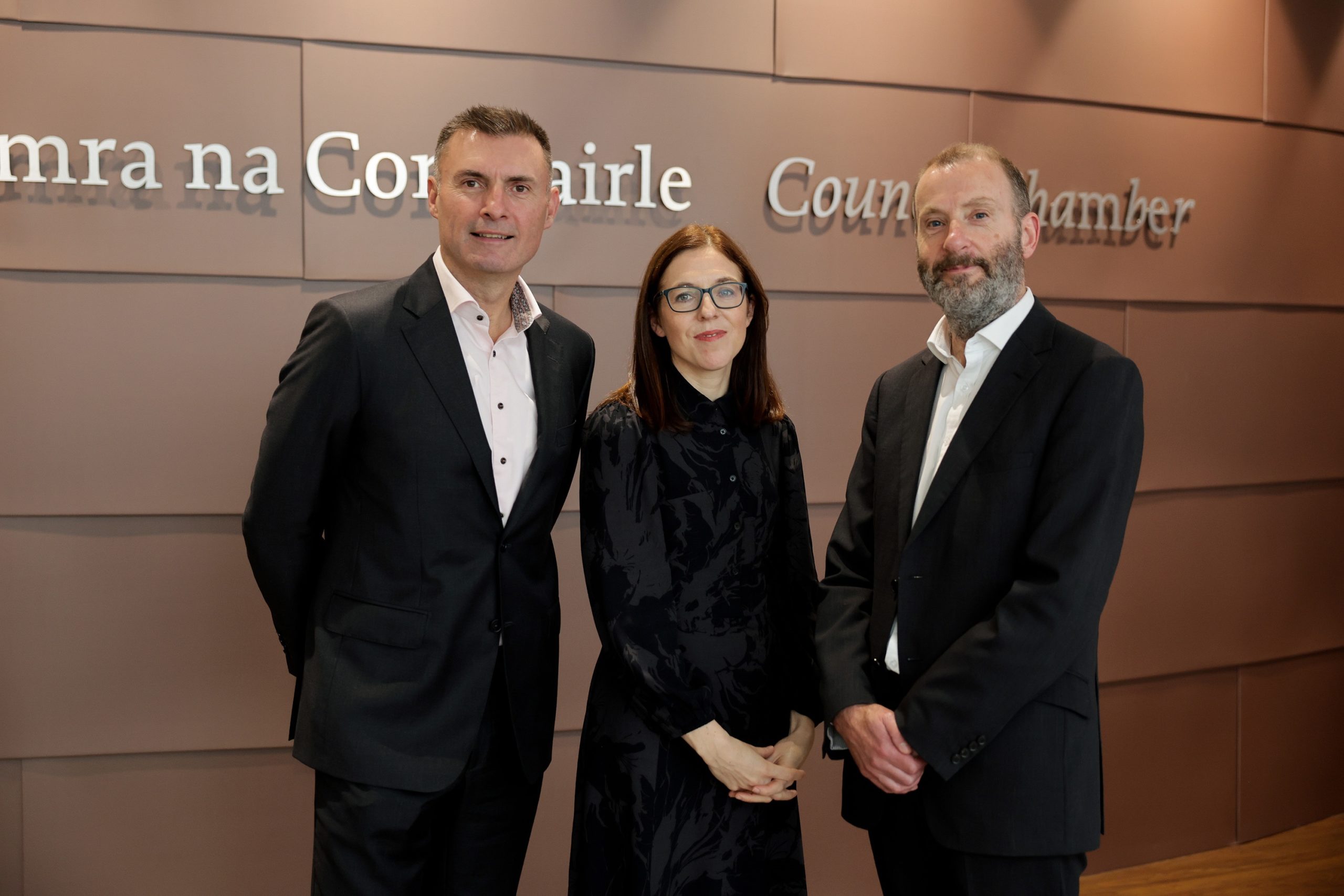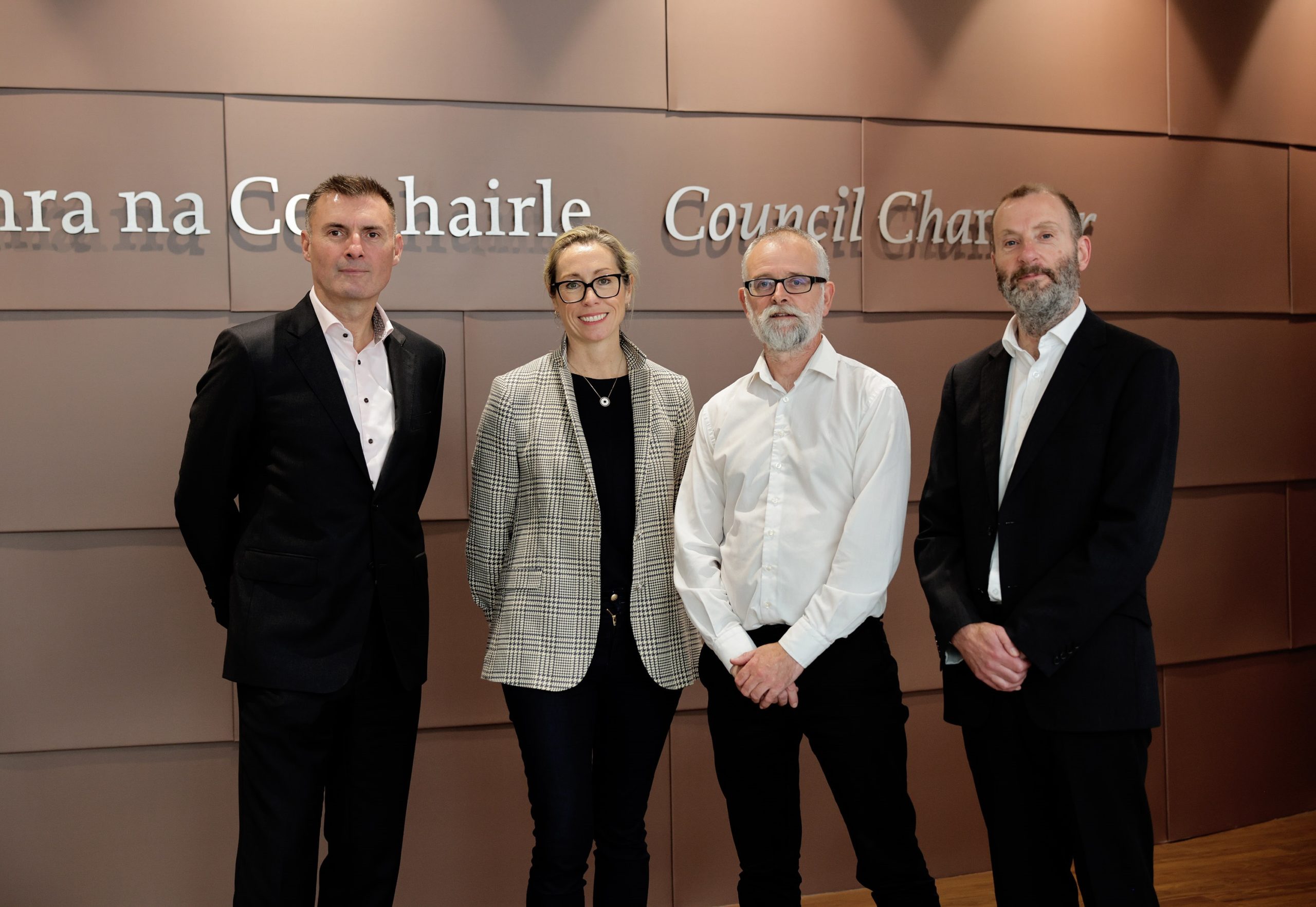
On 1 June last, SIRO launched its’ 10 Gigabit (10G) enabled broadband network in Galway city. The first city in Ireland to have this high speed, large bandwidth network at its disposal.
At the end August, SIRO’s entire fibre broadband network was upgraded to 10 Gigabits. This €10 million, 15-month upgrade project includes our full existing SIRO network, i.e., 450,000+ premises we have already passed and the further 320,000 we are in the process of passing right now.
10G: what is it?
From the middle of last year, SIRO began the process of upgrading its’ existing network to a 10 Gigabit network using XGS-PON technology.
G-PON stands for Gigabit PON or 1 Gigabit PON.
The “X” in XGS represents the number 10, and the letter “S” stands for symmetrical, XGS-PON = 10 Gigabit Symmetrical PON.
The upgrade allows SIRO to turbo-charge our existing network from a one Gigabit network to a network providing up to 10G connections which are symmetrical (same upload and download speeds), much more reliable, with lower latencies and better security.
The point of a 10G network is the flexibility to scale up seamlessly as your data demands grow. One Gigabit to two, four, six Gigabits and so on
What can it do?
One of the most prominent and headline grabbing aspects of 10 G is speed, specifically speed of data transfer. 10 Gbps lets you transfer at a rate of 1.25 GB/s when you copy a file to another computer across the SIRO network. This equates to sending a 20 GB file in under 20 seconds.

At SIRO we know, that at least for the short-to-medium term, end users of this much larger bandwidth will be enterprise/business users vs. residential consumers.
It makes sense.
It is businesses, whether small or large, who typically move large data sets. However, the number of businesses who falls into this category is not as niche as it once might have been. As ever more intensive applications run on our servers or are stored in the Cloud, the amount of data created, stored and transferred increases each day. Add in the growing automation of once manual tasks and the need for high-speed internet as the key enabler of these processes becomes clear.
10G will become the technology platform for this phase of digital adaptation across the world. It will ensure that technology in our lives becomes even more embedded and integrated
Speed and bandwidth are also important for business where large numbers of colleagues and clients need to connect at once. Both now have an expectation of being able to access services when they require them and that this access is dependable and consistent.

Business, for reasons of productivity, reputation and of course the bottom line, cannot afford to have any bottlenecks in their connectivity which can hold their business back.
Businesses with many employees and multiple clients all logging on at the same time are obvious candidates for much higher speeds. Yet over recent years as our use of digital technologies has grown, it has spawned new types of business which are equally heavy data users.
Businesses in the creative sector is one example. While they may not be big in terms of employee head count, they are big users of data. Think content creators in advertising, digital or marketing agencies, animators, film or videographers, game design – all transferring large files each day. Though smaller companies, the creative sector in its’ totality is a significant sector, employing up to 5% of the Irish workforce or about 100,000.
Do I need 10G?
In truth, it depends.
If you are an individual, doing video editing, streaming, audio production, activities which involve a large amount of data and if your workflow currently lags due to slow speeds, then likely you do need to move up the Gigabit ranks from the standard one Gigabit to higher speeds. The point of a 10G network is the flexibility to scale up seamlessly as your data demands grow. One Gigabit to two, four, six Gigabits and so on.
The use case is much clearer if you are a business or enterprise. If your business has large file sizes to deal; you use HD streaming or your company is growing in terms of capability or headcount, then there is a real risk of congestion on your network necessitating larger bandwidth.
10G will become the technology platform for this phase of digital adaptation across the world.
An important additional benefit of SIRO’s 10G network is affordability. Previously access to high-speed point-to-point (P2P) services was largely just available to very big organisations with substantial IT budgets. With this upgrade SIRO have changed that market limiting dynamic.

A 10 Gigabit Future?
Just as when once the need for one Gigabit broadband met with questions on the use case of that level of bandwidth; some might today ask a similar question of 10 Gigabit broadband.
Those of us who have seen the relentless march of data demands, know better than to ask that question anymore.
Instead, the more pertinent question for business and society to consider are what processes and technologies (many, not yet invented) can this level of bandwidth unlock for the benefit of all?
10G will become the technology platform for this phase of digital adaptation across the world. It will ensure that technology in our lives becomes even more embedded and integrated.
Healthcare professionals will monitor and diagnose their patients remotely in real-time, our students will collaborate and learn not just from their classmates but with other children across the world and virtual and augmented reality (VR and AR) will change many aspects of how we live from retail, to home entertainment, to the world of work.
In SIRO we have always sought to drive innovation in the Irish broadband market to make the probable, possible. Today’s focus may be on 10 Gigabits, but the direction of journey to 25 Gigabits is already coming into view.
To find out if your business can avail of SIRO for Business, please visit
www.siro.ie/search-your-eircode


 With Christmas just days away, there’s still time to get last minute gifts for the techie in your life. The range and price points of tech gifts now available means that you don’t necessarily have to spend a fortune either!
Tech gifts aren’t just for Christmas but can deliver convenience, more connected and smarter living, for the user long after the holidays have ended, whether in the home, at work, for entertainment or leisure.
Want to make 2023 a year of smarter living?
Read below to find out the top tech gadgets for a smarter you.
With Christmas just days away, there’s still time to get last minute gifts for the techie in your life. The range and price points of tech gifts now available means that you don’t necessarily have to spend a fortune either!
Tech gifts aren’t just for Christmas but can deliver convenience, more connected and smarter living, for the user long after the holidays have ended, whether in the home, at work, for entertainment or leisure.
Want to make 2023 a year of smarter living?
Read below to find out the top tech gadgets for a smarter you.





 With one of the busiest shopping days of the year, Black Friday, fast approaching, it’s time to start researching where to shop online and how to get the best deals.
Black Friday, once a US tradition, now a global phenomenon is where deal-savvy customers piled into shopping malls after Thanksgiving ready to buy discounted goods for Christmas.
Now, in Ireland, it’s certainly on consumers’ minds. RTE noted that Google searches for "Black Friday" had increased by 138% from 2020 to
With one of the busiest shopping days of the year, Black Friday, fast approaching, it’s time to start researching where to shop online and how to get the best deals.
Black Friday, once a US tradition, now a global phenomenon is where deal-savvy customers piled into shopping malls after Thanksgiving ready to buy discounted goods for Christmas.
Now, in Ireland, it’s certainly on consumers’ minds. RTE noted that Google searches for "Black Friday" had increased by 138% from 2020 to 
 Barry has spent over thirty-five years working in ICT. He started as a Trainee Programmer in the Northern Ireland Civil Service and progressed through various roles to eventually become the Director of ICT Shared Services and Strategy for the NI Government. Barry has been CIO for the Irish Government since April 2016 with the primary task of taking forward the Public Service ICT and eGovernment Strategies. These set out ambitions for developing the use of shared services, digital services and data to better serve the people of Ireland and ensure that Ireland is well-placed to benefit from European initiatives such as the Digital Single Market.
Barry has spent over thirty-five years working in ICT. He started as a Trainee Programmer in the Northern Ireland Civil Service and progressed through various roles to eventually become the Director of ICT Shared Services and Strategy for the NI Government. Barry has been CIO for the Irish Government since April 2016 with the primary task of taking forward the Public Service ICT and eGovernment Strategies. These set out ambitions for developing the use of shared services, digital services and data to better serve the people of Ireland and ensure that Ireland is well-placed to benefit from European initiatives such as the Digital Single Market.

 SIRO is
SIRO is  SIRO, a joint venture between ESB and Vodafone, is currently rolling out a 100% fibre broadband network across 154 towns and cities across Ireland, with services currently available to 450,000+ premises and reaching 770,000 premises over the next four years. The company rolls out its 100% fibre broadband network by using the existing ESB electricity network and following it into the heart of each home and business.
The broadband network operator already has a significant network presence in North Dublin, where its rollout is ongoing and where the SIRO network has already passed over 60,000 homes and businesses.
The company places a strong emphasis on bringing innovation to the Irish broadband market. Over the last 12 months, it has launched 2 Gigabits speeds for residential users and up to 10 Gigabits for enterprise.
SIRO, a joint venture between ESB and Vodafone, is currently rolling out a 100% fibre broadband network across 154 towns and cities across Ireland, with services currently available to 450,000+ premises and reaching 770,000 premises over the next four years. The company rolls out its 100% fibre broadband network by using the existing ESB electricity network and following it into the heart of each home and business.
The broadband network operator already has a significant network presence in North Dublin, where its rollout is ongoing and where the SIRO network has already passed over 60,000 homes and businesses.
The company places a strong emphasis on bringing innovation to the Irish broadband market. Over the last 12 months, it has launched 2 Gigabits speeds for residential users and up to 10 Gigabits for enterprise.
 Commenting on the announcement, SIRO CEO John Keaney noted:
“Poor broadband is not exclusively a regional issue. Anyone who lives in or runs a business in our capital and its suburbs can also face connectivity issues.
“SIRO is working to address this issue, giving residents and businesses of South County Dublin access to world class broadband. Today’s announcement sets out our intent for areas in Dún Laoghaire Rathdown over the next two years.
“In addition to our roll-out in North Dublin and Fingal, which is well advanced and ongoing, we are now committing to bring world-class fibre connectivity to tens of thousands of more premises across South Dublin,” added Mr. Keaney.
Dún Laoghaire Rathdown Local Authority CEO Frank Curran welcoming SIRO’s investment stated: “In an increasingly digitised world SIRO’s planned fibre broadband rollout is a most welcome development in Dún Laoghaire Rathdown.
“This type of high-speed connectivity infrastructure directly affects thousands of homes and businesses in a very positive way.
We look forward to working with SIRO to ensure this project is brought to fruition for everyone’s benefit.”
[lookup_modal type="eircode" button-text="Search Your Eircode Today" position="mid" title="Search Your Eircode Today"]
Commenting on the announcement, SIRO CEO John Keaney noted:
“Poor broadband is not exclusively a regional issue. Anyone who lives in or runs a business in our capital and its suburbs can also face connectivity issues.
“SIRO is working to address this issue, giving residents and businesses of South County Dublin access to world class broadband. Today’s announcement sets out our intent for areas in Dún Laoghaire Rathdown over the next two years.
“In addition to our roll-out in North Dublin and Fingal, which is well advanced and ongoing, we are now committing to bring world-class fibre connectivity to tens of thousands of more premises across South Dublin,” added Mr. Keaney.
Dún Laoghaire Rathdown Local Authority CEO Frank Curran welcoming SIRO’s investment stated: “In an increasingly digitised world SIRO’s planned fibre broadband rollout is a most welcome development in Dún Laoghaire Rathdown.
“This type of high-speed connectivity infrastructure directly affects thousands of homes and businesses in a very positive way.
We look forward to working with SIRO to ensure this project is brought to fruition for everyone’s benefit.”
[lookup_modal type="eircode" button-text="Search Your Eircode Today" position="mid" title="Search Your Eircode Today"]  On 1 June last, SIRO launched its’ 10 Gigabit (10G) enabled broadband network in Galway city. The first city in Ireland to have this high speed, large bandwidth network at its disposal.
At the end August, SIRO’s entire fibre broadband network was upgraded to 10 Gigabits. This €10 million, 15-month upgrade project includes our full existing SIRO network, i.e., 450,000+ premises we have already passed and the further 320,000 we are in the process of passing right now.
On 1 June last, SIRO launched its’ 10 Gigabit (10G) enabled broadband network in Galway city. The first city in Ireland to have this high speed, large bandwidth network at its disposal.
At the end August, SIRO’s entire fibre broadband network was upgraded to 10 Gigabits. This €10 million, 15-month upgrade project includes our full existing SIRO network, i.e., 450,000+ premises we have already passed and the further 320,000 we are in the process of passing right now.
 At SIRO we know, that at least for the short-to-medium term, end users of this much larger bandwidth will be enterprise/business users vs. residential consumers.
It makes sense.
It is businesses, whether small or large, who typically move large data sets. However, the number of businesses who falls into this category is not as niche as it once might have been. As ever more intensive applications run on our servers or are stored in the Cloud, the amount of data created, stored and transferred increases each day. Add in the growing automation of once manual tasks and the need for high-speed internet as the key enabler of these processes becomes clear.
At SIRO we know, that at least for the short-to-medium term, end users of this much larger bandwidth will be enterprise/business users vs. residential consumers.
It makes sense.
It is businesses, whether small or large, who typically move large data sets. However, the number of businesses who falls into this category is not as niche as it once might have been. As ever more intensive applications run on our servers or are stored in the Cloud, the amount of data created, stored and transferred increases each day. Add in the growing automation of once manual tasks and the need for high-speed internet as the key enabler of these processes becomes clear.
 Business, for reasons of productivity, reputation and of course the bottom line, cannot afford to have any bottlenecks in their connectivity which can hold their business back.
Businesses with many employees and multiple clients all logging on at the same time are obvious candidates for much higher speeds. Yet over recent years as our use of digital technologies has grown, it has spawned new types of business which are equally heavy data users.
Businesses in the creative sector is one example. While they may not be big in terms of employee head count, they are big users of data. Think content creators in advertising, digital or marketing agencies, animators, film or videographers, game design – all transferring large files each day. Though smaller companies, the creative sector in its’ totality is a significant sector, employing up to 5% of the Irish workforce or about 100,000.
Business, for reasons of productivity, reputation and of course the bottom line, cannot afford to have any bottlenecks in their connectivity which can hold their business back.
Businesses with many employees and multiple clients all logging on at the same time are obvious candidates for much higher speeds. Yet over recent years as our use of digital technologies has grown, it has spawned new types of business which are equally heavy data users.
Businesses in the creative sector is one example. While they may not be big in terms of employee head count, they are big users of data. Think content creators in advertising, digital or marketing agencies, animators, film or videographers, game design – all transferring large files each day. Though smaller companies, the creative sector in its’ totality is a significant sector, employing up to 5% of the Irish workforce or about 100,000.




 SIRO is a joint venture company between ESB and Vodafone, founded in 2015. SIRO’s state-of-the-art fibre broadband network is built on the ESB electricity infrastructure, trusted for its reliability and resilience. Overall, the company is investing more than €1 billion in delivering high speed, future proofed broadband across Ireland to 154 cities and towns.
The company already has a significant presence in North Dublin where it is available to
SIRO is a joint venture company between ESB and Vodafone, founded in 2015. SIRO’s state-of-the-art fibre broadband network is built on the ESB electricity infrastructure, trusted for its reliability and resilience. Overall, the company is investing more than €1 billion in delivering high speed, future proofed broadband across Ireland to 154 cities and towns.
The company already has a significant presence in North Dublin where it is available to  Commenting on the sponsorship, Michael Keegan, who helps run the academy at Trinity Donaghmede FC notes:
“Before Covid hit we had 17 teams within the club. Since then, this has grown by a further 7 teams to 24 today. Ideally every team needs a sponsor. What this sponsorship does is give an incredible boost for the club - kids, managers / parents, which can’t be underestimated.
“It is a huge boost for all involved. Without a sponsor's kind generosity, the club wouldn't exist"
“Most of all, the kids' faces and their excitement when they receive the new gear is priceless! It's all voluntary, so getting yearly sponsorships is massive for our club. It makes it all worthwhile.”
SIRO is available in Donaghmede and across Fingal. For more information on if SIRO is available for your home or business, please visit
Commenting on the sponsorship, Michael Keegan, who helps run the academy at Trinity Donaghmede FC notes:
“Before Covid hit we had 17 teams within the club. Since then, this has grown by a further 7 teams to 24 today. Ideally every team needs a sponsor. What this sponsorship does is give an incredible boost for the club - kids, managers / parents, which can’t be underestimated.
“It is a huge boost for all involved. Without a sponsor's kind generosity, the club wouldn't exist"
“Most of all, the kids' faces and their excitement when they receive the new gear is priceless! It's all voluntary, so getting yearly sponsorships is massive for our club. It makes it all worthwhile.”
SIRO is available in Donaghmede and across Fingal. For more information on if SIRO is available for your home or business, please visit